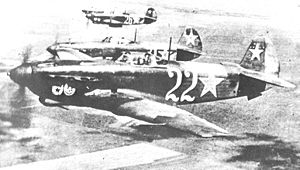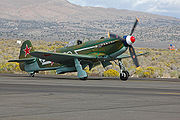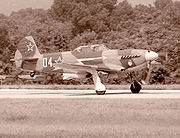Yakovlev Yak-9 Videos
|
Loading...
|
|
|
Loading...
|
|
 (Image: Yak-9D of
the Soviet Air Force)
(Image: Yak-9D of
the Soviet Air Force)
Role: Fighter
Manufacturer: Yakovlev OKB
Designed by: Alexander Sergeevich Yakovlev
First flight: Summer 1942
Introduced: October 1942
Primary user: Soviet Air Force
Produced: 1942-1948
Number built: 16,769
Developed from: Yak-1
Low pass with P-51 Mustang
The Yakovlev Yak-9 was a single-engine fighter aircraft used by the Soviet Union in World War II and after. It was the most numerous Soviet fighter of the war and remained in production from 1942 to 1948, with 16,769 built.
Design and development
The Yak-9 represented further development of the successful Yakovlev Yak-7 fighter, a production version of the lightened Yak-7DI, taking full advantage of the combat experience with its predecessor. Greater availability of duralumin allowed for lighter construction which in turn permitted a number of modifications to the basic design.
Yak-9 variants carried two different wings, five different engines, six different fuel tank combinations and seven types of armament configurations.
Operational history
World War II
The first Yak-9 represented and it entered service in October 1942. Yak-9s first saw combat in late 1942 during the Battle of Stalingrad.
Post-war
During 1949, the USSR provided surplus Yak-9P (VK-107) aircraft to some satellite states in the Soviet bloc in order to help them rebuild their air forces in the wake of West Berlin's blockade and the allied airlift. A section of the plane's operating manual was accidentally omitted from the translation from Russian into some languages: before starting the Yak-9, it was necessary to hand-crank a small cockpit-mounted oil pump 25 times to provide initial lubrication to the Klimov inline vee engine, unlike World War II German and Western fighters equipped with forced closed-cycle lubrication systems. Skipping this unusual but vital step resulted in frequent engine seizure during take-off roll and initial climb, causing several fatalities during 1950.
Variants
 (Image: Modern
built Yak-9M as Yak-9U)
(Image: Modern
built Yak-9M as Yak-9U)
Yakovlev OKB created 22 modifications of the Yak-9, of which 15 saw mass production. The most notable of these include:
Yak-9
First production version, Klimov M-105PF engine with 880 kW (1,180 hp), 1 x 20 mm ShVAK cannon with 120 rounds and 1 x 12.7 mm UBS machine gun with 200 rounds.
Yak-9 (M-106)
Prototype with Klimov M-106-1SK engine with 1,007 kW (1,350 hp), did not advance to production because of problems with the engine.
Yak-9T
 (Image:
Modern built Yak-9 on takeoff at World War II Air Show, Reading, PA, 2002)
(Image:
Modern built Yak-9 on takeoff at World War II Air Show, Reading, PA, 2002)
Yak-9 armed with a 37 mm Nudelman-Suranov NS-37 cannon with 30 rounds instead of the 20 mm ShVAK, cockpit moved 0.4 m (1 ft 3 in) back to compensate for the heavier nose. Initially poor quality control led to multiple oil and coolant leaks from cannon recoil. Recoil and limited supply of ammunition required accurate aiming and two-three round bursts. Yak-9T was widely used against enemy shipping on the Black Sea and against tanks, but was also successful against aircraft with a single cannon hit usually sufficient to tear apart the target. Time to turn a complete circle: 18-19 sec.
Yak-9TK
Yak-9T with the ability to install either the 20 mm ShVAK, the 23 mm VYa, the 37 mm NS-37, or the 45 mm NS-45 cannon in the "vee" of the engine block. Did not enter production because the difference between 20 mm and 23 mm cannons was insignificant and the 45 mm cannon was unreliable.
Yak-9K
Yak-9T modified with a 45 mm NS-45 cannon with 29 rounds and a distinctive muzzle brake to deal with the massive recoil. Firing the cannon at speeds below 350 km/h (220 mph) caused dramatic loss of control and tossed the pilot back and forth in the cockpit, however accurate shooting was possible at higher speeds and in 2-3 round bursts. The recoil also caused numerous oil and coolant leaks. The heavy cannon installation degraded performance sufficiently to require fighter escort. Yak-9K saw only limited use due to unreliability of the NS-45.
Yak-9D
Long-range version of Yak-9, fuel capacity increased from 440 l (115 US gal) to 650 l (170 US gal) giving a maximum range of 1,360 km (845 mi). Combat usefulness at full range was limited by lack of radio navigation equipment, and a number of aircraft were used as short-range fighters with fuel carried only in inner wing tanks. Circle time: 19-20 sec. Weight of fire: 2 kg (4.4 lb)/sec.
Yak-9TD
Yak-9D with NS-37 cannon and provision for 4 x 50 kg (110 lb) FAB-50 bombs under the wings.
Yak-9B
Fighter-bomber version of Yak-9D (factory designation Yak-9L) with four vertical tube bomb bays aft of the cockpit with capacity for up to 4 x 100 kg (220 lb) FAB-100 bombs or 4 PTAB cassettes with 32 x 1.5 kg (3.3 lb) bomblets each, although normally only 200 kg (440 lb) of weapons were carried in the front bomb bays. Poor handling with a full bomb and fuel load and lack of special aiming equipment limited combat usefulness.
Yak-9DD
Yak-9D and Yak-9T modified to further increase the range, fuel capacity increased to 845 l (220 US gal) giving a maximum range of 2,285 km (1,420 mi), radio navigation equipment for night and poor weather flying. Yak-9DD were used primarily to escort Petlyakov Pe-2 and Tupolev Tu-2 bombers although they proved less than ideal for this role due to insufficient speed advantage over the bombers. In 1944, several Yak-9DD were used to escort B-17 Flying Fortress and B-24 Liberator bombers attacking targets in Romania using the Ukraine-Romania-Italy routes.
Yak-9M
Yak-9D with the cockpit moved 0.4 m (1 ft 4 in) to the rear like on Yak-9T, numerous fixes and improvements based on experience with previous versions.
Yak-9M PVO
Yak-9M with slightly reduced fuel capacity, Klimov VK-105PF2 engine with 925 kW (1,240 hp), and radio and navigational equipment for night and adverse weather flying for PVO Strany.
Yak-9 MPVO
Single-seat night fighter aircraft, equipped with a searchlight and an RPK-10 radio compass.
Yak-9S
Yak-9M with Klimov VK-105PF engine, new propeller, and armament consisting of 1 x 23 mm Nudelman-Suranov NS-23 cannon with 60 rounds, and 2 x 20 mm Berezin B-20 cannons with 120 rpg. Did not enter production due to poor performance compared to Yak-3 and Yak-9U.
Yak-9R
Single-seat tactical reconnaissance aircraft.
Yak-9P
UBS machine gun replaced with a second 20 mm ShVAK with 175 rounds, did not enter production due to the decision to use larger caliber cannons.
Yak-9P (VK-107)
Yak-9U with an all-metal wing, Yak-9P in this case was a factory designation different from Yak-9P with two ShVAKs (see above).
Yak-9PD
High-altitude interceptor (unrelated to the two other Yak-9P above) with Klimov M-105PD engine designed specifically to intercept Luftwaffe Junkers Ju 86R high-altitude reconnaissance aircraft overflying Moscow in 1942–1943. Initially poor performance due to unreliable engine dramatically improved with adoption of Klimov M-106PV with water injection, with the aircraft reaching 13,500 m (44,300 ft) during testing. Armament reduced to the ShVAK cannon only to save weight.
Yak-9U (VK-105)
Yak-9T with Klimov VK-105PF2 engine and numerous aerodynamic and structural improvements introduced on Yak-3. Main visual difference from Yak-9T was in the oil coolers in the wing roots like on Yak-3 and in plywood covering of the fuselage instead of fabric. Visually differed from Yak-3 only by main landing gear covers. Armament increased to 1 x 23 mm VYa with 60 rounds and 2 x 12.7 mm UBSs with 170 rpg. The VYa cannon could be replaced by a ShVAK, B-20, or NS-37, the latter requiring removal of the starboard UBS machine gun. Did not enter production because the VYa cannon was considered unsatisfactory and because the one cannon, one machine gun armament seen on previous models offered a significant increase in range.
Yak-9U (VK-107)
The definitive Yak-9 variant, Yak-9U (VK-105) equipped with the new Klimov VK-107A engine with 1,230 kW (1,650 hp), and the 20 mm ShVAK with 120 rounds replacing the VYa. Weight of fire: 2.72 kg (5.98 lb)/sec. Early test flights in 1943 indicated that the only comparable Soviet fighter was Polikarpov I-185 prototype which was more difficult to fly and less agile due to higher weight. The prototype's top speed of 700 km/h (435 mph) at 5,600 m (18,370 ft) was faster than any production fighter aircraft in the world at the time. Early problems with overheating were fixed by enlarging the radiators and production aircraft had further improved aerodynamics. Turning ability to complete a circle: 20 sec, best Soviet fighter at altitude.
Yak-9UV
Two-seat trainer version of Yak-9U (VK-107), armament reduced to a single Berezin B-20 cannon with 100 rounds. Did not enter production due to introduction of jet aircraft.
Yak-9UT
Yak-9U (VK-107) armed with 1 x 37 mm Nudelman N-37 cannon with 30 rounds and 2 20 mm Berezin B-20 cannons with 120 rpg, giving a one-second burst mass of 6 kg (13.2 lb). Similarly to Yak-9TK could be converted to replace the N-37 with a 20 mm B-20, 23 mm NS-23, or 45 mm N-45. Production aircraft carried NS-23 instead of the N-37 cannon as the default armament.
Yak-9V
Two-seat trainer version of Yak-9M and Yak-9T, Klimov VK-105PF2 engine, armament reduced to 1 x 20 mm ShVAK with 90 rounds.
Modern recreations
In the early 1990s, Yakovlev started limited production for the warbird market of Yak-9 and Yak-3 aircraft using original World War II equipment and Allison V-1710 engines.
Operators
Yak-9 operators
Albania
Albanian Air Force received 12 aircraft in 1951.
Bulgaria
Bulgarian Air Force
People's Republic of China
People's Liberation Army Air Force
France
Armée de l'Air
Normandie-Niemen squadron
Hungary
Hungarian Air Force received aircraft in 1949.
Mongolia
Mongolian People's Air Force received 31 aircraft in 1945.
North Korea
North Korean Air Force
Poland
Polish Air Force operated several aircraft from 1947 to 1953.
Soviet Union
Soviet Air Force
Yugoslavia
SFR Yugoslav Air Force
Specifications (Yak-9D)
General characteristics
Crew: one
Length: 28 ft 0 in (8.55 m)
Wingspan: 31 ft 11 in (9.74 m)
Height: 9 ft 10 in (3.00 m)
Wing area: 185.1 ft² (17.2 m²)
Empty weight: 5,170 lb (2,350 kg)
Loaded weight: 6,858 lb (3,117 kg)
Max takeoff weight: lb (kg)
Powerplant: 1x Klimov M-105 PF V-12 liquid-cooled piston engine, 1,180 hp (880 kW)
Performance
Maximum speed: 367 mph at altitude (591 km/h)
Range: 845 miles (1,360 km)
Service ceiling: 30,000 ft (9,100 m)
Rate of climb: 2,690 ft/min (13.7 m/s)
Wing loading: 37 lb/ft² (181 kg/m²)
Power/mass: 0.17 hp/lb (0.28 kW/kg)
Armament
1 x 20 mm ShVAK cannon, 120 rounds
1 x 12.7 mm UBS machine gun, 200 rounds
Specifications (Yak-9U (VK-107))
General characteristics
Crew: one
Length: 28 ft 0 in (8.55 m)
Wingspan: 31 ft 11 in (9.74 m)
Height: 9 ft 10 in (3.00 m)
Wing area: 185.1 ft² (17.2 m²)
Empty weight: 5,526 lb (2,512 kg)
Loaded weight: 7,049 lb (3,204 kg)
Max takeoff weight: lb (kg)
Powerplant: 1x Klimov VK-107A V-12 liquid-cooled piston engine, 1,500 hp (1,120 kW)
Performance
Maximum speed: 417 mph at altitude (672 km/h)
Range: 420 miles (675 km)
Service ceiling: 35,000 ft (10,650 m)
Rate of climb: 3,280 ft/min (16.7 m/s)
Wing loading: 38 lb/ft² (186 kg/m²)
Power/mass: 0.21 hp/lb (0.35 kW/kg)
Armament
1 x 20 mm ShVAK cannon, 120 rounds
2 x 12.7 mm UBS machine guns, 170 rpg
Related development
Yak-1
Yak-3
Yak-7
Yak-11
Comparable aircraft
Bell P-39 Airacobra
North American P-51 Mustang
Messerschmitt Me 109
Focke-Wulf FW 190
Supermarine Spitfire
References
Notes
Bibliography
Bock, Robert. Yak-7, Yak-9 (Aircraft Monograph 14) (English translation of Polish original). Gda?sk, Poland: AJ-Press, 1999. ISBN 83-7237-020-6.
Gordon, Yefim and Dmitri Khazanov. Soviet Combat Aircraft of the Second World War, Volume One: Single-Engined Fighters. Earl Shilton, Leicester,
UK: Midland Publishing Ltd., 1998. ISBN 1-85780-083-4.
Green, William. Warplanes of the Second World War, Volume Three: Fighters. London: Macdonald & Co. (Publishers) Ltd., 1961 (seventh impression
1973). ISBN 0-356-01447-9.
Green, William and Gordon Swanborough. WW2 Aircraft Fact Files: Soviet Air Force Fighters, Part 2. London: Macdonald and Jane's Publishers Ltd.,
1978. ISBN 0-354-01088-3.
Kopenhagen, W., ed. Das große Flugzeug-Typenbuch. Stuggart, Germany: Transpress, 1987. ISBN 3-344-00162-0.
Liss, Witold. The Yak 9 Series (Aircraft in Profile number 185). Leatherhead, Surrey, UK: Profile Publications Ltd., 1967.
Mellinger, George. Yakovlev Aces of World War 2. Botley, UK: Osprey Publishing Ltd., 2005. ISBN 1-84176-845-6.
Morgan, Hugh. Soviet Aces of World War 2. London: Reed International Books Ltd., 1997. ISBN 1-85532-632-9.
Panek, Robert. Yakovlev Yak-9U & P. Sandomierz, Poland/Redbourn, Hertfordshire, UK: Mushroom Model Publications, 2006. ISBN 83-89450-27-5.
Living Warbirds: The best warbirds DVD series.
Source: WikiPedia